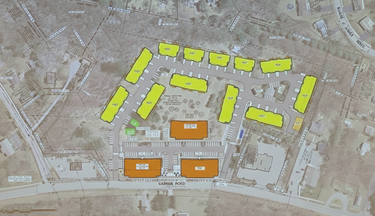New developers ask residents about Carman Road apartment project proposed for fourth time
GUILDERLAND — The new developers of a long-stalled multi-unit housing development on Carman Road were little more than cannon fodder for the approximately two dozen residents who came to the Guilderland Public Library recently to ask that the project not be built.
This marks the fourth attempt since 2019 that developers have attempted to gain approval from the town to build multiple apartment buildings on the 16-acre site at 3633 Carman Road.
The Aug. 21 meeting at the library was unusual in that developers Michael Fiacco and Jared George chose to engage the public before making a formal submission to the town, even one to the development planning committee.
That committee, an advisory group made up of staff from different town departments, sees only a few applications per year. The projects are often controversial, leading most developers to want to get out in front of any issues before residents have a chance to cut down the proposal.
The not-municipal-board-nature of the Aug. 21 meeting was acknowledged up front by Fiacco, who told attendees that he and George are “trying to get as much feedback from neighbors as possible.”
Fiacco, for whom real-estate development appears to be a side line as he also spends time as president and owner of Old Brick Furniture, said he and George met informally with the town as well as some neighbors.
“We made some adjustments based on their feedback,” he said.
He also said that he and George were “trying to be proactive in our approach,” because “we know the prior development team wasn’t proactive; they just went to town and submitted. We’re here to give everybody our plan and why we think this plan is right for the space.”
History
In 2019, Rosetti Properties was before the town’s development planning committee, seeking feedback for its a 12-building, 120-apartment proposal called Dutch Mill Acres.
Zoning was Rosetti’s first issue.
The parcel is the only property for miles zoned general business, which Rosetti at the time was seeking to change to allow for more multi-unit development on the site.
Town staff in 2019 said there may not have been support for the zone change, based on the Fort Hunter and Carman Road neighborhood Transportation Plan, one of a number of neighborhood-specific studies recommended as part of Guilderland’s last adopted comprehensive land-use plan, in 2001.
Guilderland staff recommended a new Traditional Neighborhood Development District (TNDD) for this and other transitional areas “for more of a pedestrian friendly, neighborhood scale, mix of small-sized local commercial uses interspersed with and/or incorporating a secondary mix of onsite residential uses,” according to the meeting minutes.
The new TNDD designation, according to minutes, “would in many ways mirror the more traditional Planned Unit Development Districts (PUD) found in larger parcel developments, but would provide for smaller-scaled, context sensitive, in-fill development in areas physically limited by existing/adjacent development.”
The proposal was denied by the town board, which led Rosetti to come back in February 2020 seeking a 132-unit apartment and townhouse development, proposing five apartment buildings, each consisting of 20 units, and eight townhome-style buildings with four units each as well as 3,000 square feet of commercial space.
By January 2021, having previously come to the town with plans that included more units but were out of sync with Guilderland’s intended development goals for the area, Rosetti’s request was to build a 96-unit townhome development. His plan was panned by the town’s land-use advisory committee at time since 98 percent of total buildout was for housing.
“The outstanding features of a PUD are diversity, flexibility and variety of development as spelled out in the zoning ordinance,” according to meeting minutes. “This plan seems to lack these elements.”
It was in this churn that the project’s newest developers took their place.
Current proposal
The proposal from Fiacco and George continues to carry the name Dutch Mill Acres.
The proposed PUD, per the development team’s presentation, is a “thoughtfully scaled community with 125 two-story units (7.7 units/acre)” and a roughly 6,000-square-foot first-floor commercial space along Carman Road.
Planned Unit Developments require a rezone through the passage of a new local law. The town board is the lead agency on PUD applications.
The project would be a mixture of one- and two-bedroom units, ranging in size from 900 to 1,250 square feet.
According to the presentation, 78 of the townhouse-style units would have an attached garage with driveway, effectively giving each of the units two parking spots, while there’d be an additional 130 surface spaces for the remaining units, to be located in one of three two-story apartment buildings on the site.
It’s noted that 15 percent “of the homes will be offered at reduced rents for essential community members such as Ft. Hunter fire volunteers, police, EMS, and teachers,” a reference to workforce housing, where a household earns 80 percent of the area median income. Fiacco and George used $107,500 as the area median income, so the cutoff for reduced rent would be an annual income of $86,000.
Attendees’ issues with the project covered nearly all the typical concerns residents have with development: traffic, environmental damage, and if the proposal is even right for the area.
George said that a prior traffic study performed for Rosetti is “just going be updated,” to which Robyn Gray of the Guilderland Coalition for Responsible Growth quickly noted, “That was a computer-generated traffic study. You have had three roundabouts added to that road,” since the previous study.
The Rosetti proposal estimated that its project would generate 66 new vehicle trips during a single a.m. peak hour, while 95 new vehicle trips were expected in a single p.m. peak hour.
“This is a lot larger than what Mr. Rossetti had originally proposed,” Gray said. “So you’re looking at at least 25 more apartments, which to me says you're probably looking at another 40 extra cars.”
After more discussion about issues in the area, Gray pressed Fiacco and George “to commit to doing a real traffic study, not an update,” to which the pair relented.
Some residents described the neighborhood as already plagued by significant drainage and saturation problems, an issue they felt would only get worse with construction.
The addition of homes and paving for parking lots would lead to a reduction in permeable soil and corresponding increase in site runoff, it was said, resulting in more stormwater being pushed onto adjacent properties, exacerbating an already difficult situation.
Particularly during the spring, Fiacco and George were told, flooded basements and yards are all too common in the neighborhood.
“I know the water situation is difficult,” said neighborhood resident and former Councilwoman Rosemary Centi. “The culverts on Carman were filled all spring,” which led to a number of residents’ front lawns being under water.
Other than Fiacco engaging Centi about specific locations where flooding had occurred, the developers’ presentation didn’t offer much in the way of a solution, other than to note that about half of the project site would be preserved open space.
During their presentation, Fiacco and George highlighted some of Carman Road’s existing apartment developments, which the pair meant to illustrate the more upscale nature of their own project but instead led to attendees objecting to the use of existing apartments on Carman Road to justify more.
With a fear that more apartments could lead to the urbanization of Carman Road, there was a hope that Fiacco and George might consider an alternative.
“This is a plan,” neighborhood resident John Haluska told attendees on Aug. 21. “In my estimation, it is not the best plan.”
Haluska then asked Fiacco and George how familiar they were with small-home development, where 700- to 900-square-foot homes are built on lots no larger than 60 feet by 101 feet. The idea, Haluska said, has been implemented elsewhere, citing Canada and Europe as examples.
Haluska estimated 40 homes could be built on the 16-acre site.
“And I say homes in particular, because it’s something that people can buy and sell,” Haluska said, adding that starter homes are difficult to come by in Guilderland, where median home sales are “in excess of $400,000.”
Haluska told Fiacco and George that a small-home development would be “an ideal advertisement for future similar endeavors in other parts of the region; this would be a helluva ad for you guys.”
But market realities — high per-unit costs as well as lumber and labor prices, for example — make detached homes an expensive endeavor.
A survey by the National Association of Home Builders found that, in 2024, the cost to build a “new single-family residence stands at approximately $162 per square foot, excluding the cost of the finished lot.” That figure is up $10 per square foot from 2023 and $59 per square foot from a decade earlier.
According to the builders’ association, its “most recent Construction Cost survey (conducted in the Fall of 2024) shows that, on average, 64.4% of the sales price is due to construction costs and 13.7% to finished lot costs. On average, builder profit is 11.0% of the sales price.”
The NAHB largely attributed the year-over-year increases to the cost of building materials and elevated wage growth in the home-building industry.
Depending on size, quality of materials used, and complexity of design, the cost to build one- to three-story multi-unit housing can run from as low as $90 per square foot up to as much as $575 per square foot.



